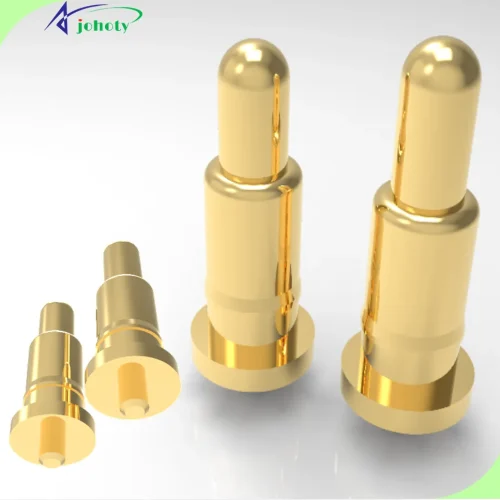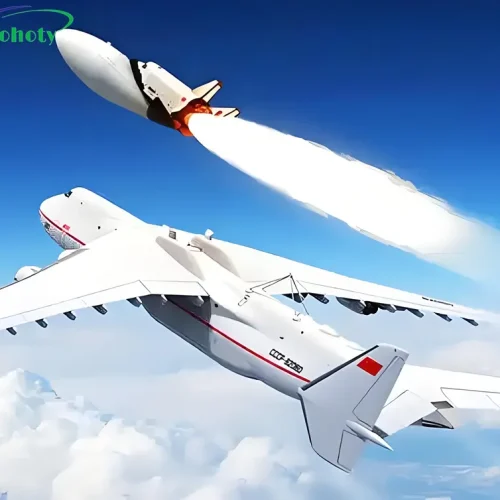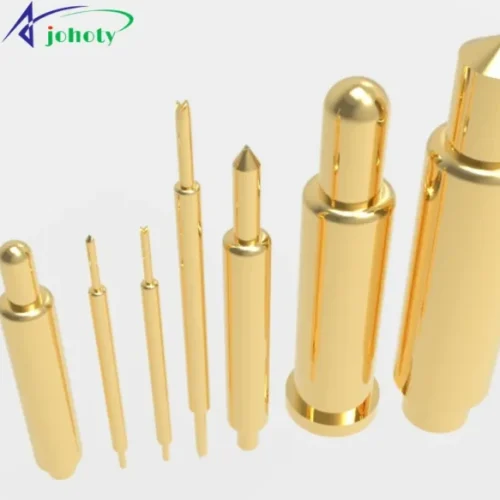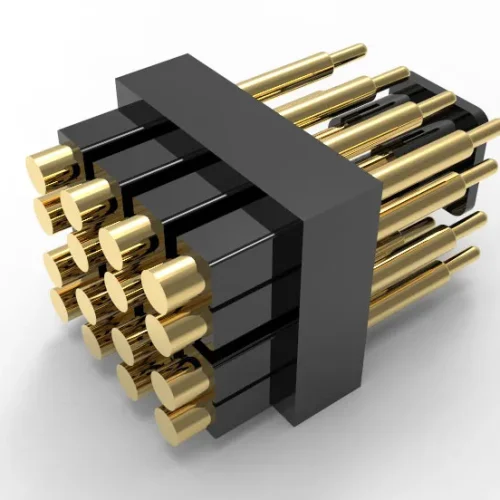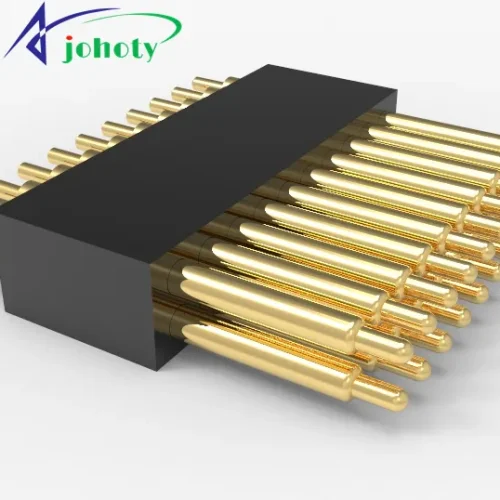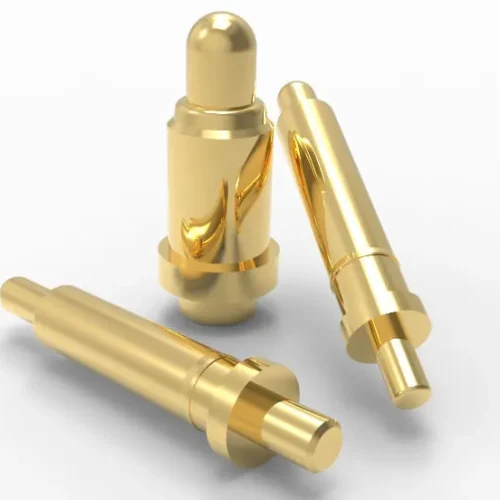What is a Lead Screw? Discover Its Benefits and Applications in Our Complete Guide from Johoty. Learn How It Enhances Precision in Machinery
Introduction
A lead screw is a key component in mechanical systems, driving linear motion and widely used in precision manufacturing, automation, and various industrial applications. Known for efficiently converting rotational movement into linear action, it enhances mechanical precision while reducing friction and noise.
What is a Lead Screw? In this guide from Johoty, we’ll dive deep into how lead screws work, their main applications, and their critical role in modern mechanical engineering. Whether you’re an engineer, designer, or simply interested in mechanical systems, this guide offers valuable insights into how lead screws can optimize performance and accuracy.
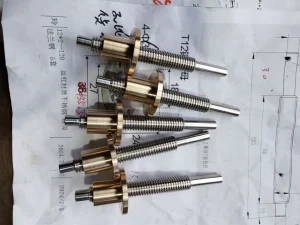
How Lead Screws Work: What is a Lead Screw?
Rotation-to-Linear Conversion Efficiency:
- Lead screws use threaded designs to convert rotational movement into linear motion. Efficiency depends on friction and thread geometry. Trapezoidal threads typically achieve 30%-50% efficiency, while precision square threads can reach up to 70%-80%. This makes lead screws ideal for high-load, low-speed systems.
- For example, an M16 trapezoidal screw moves 4mm per rotation, and under a 200N load, achieves 45% efficiency, meaning 100Nm of torque translates to 45Nm of linear force.
Pitch vs. Precision:
- The pitch determines how much linear movement occurs with each rotation. Smaller pitches allow for finer control, ideal for high-precision settings. A 1mm pitch screw moves just 1mm per turn with less than 0.01mm error, perfect for precision machinery.
- In high-precision setups, a 0.5mm pitch lead screw can achieve ±0.005mm repeat accuracy, crucial for semiconductor manufacturing and lab equipment.
Friction and Efficiency Optimization:
- Friction significantly impacts lead screw efficiency. Metal-to-metal contact screws have high friction (0.15-0.2), but using PTFE or self-lubricating nuts can lower friction to around 0.05, boosting efficiency and extending lifespan.
- For example, a copper alloy nut has a friction coefficient of 0.18, while a PTFE-lined nut drops to 0.06, raising efficiency from 35% to 60%.
Self-locking and Load Holding:
- One big advantage of lead screws is their self-locking ability. When the screw has a larger pitch, friction prevents the nut from moving backward without external force. This is especially important in heavy machinery, where load position remains stable even when power is cut off.
- For example, a 5mm pitch M20 screw, under a 500N load, has a static self-locking torque of 25Nm, ensuring the load won’t slip even if the system loses power.
Backlash and Precision Control:
- Backlash affects lead screw precision, especially in systems with frequent direction changes. Using a double nut preload system, backlash can be reduced to below 0.02mm, ensuring high-precision linear motion. This is crucial for CNC machines and precision manufacturing.
- In high-precision setups, adjusting the preload between the nuts can reduce positioning errors to under 0.005mm, ensuring repeatable accuracy.
Load Capacity and Fatigue Life:
- A lead screw’s load capacity depends on material strength and thread design. For example, a steel trapezoidal screw can handle thousands of newtons in static load, while optimized thread design can extend fatigue life to millions of cycles, ensuring long-term stability.
- A C45 steel M25 screw, for instance, has a maximum static load capacity of 8000N, and after 500,000 fatigue cycles, its mechanical performance degrades by less than 3%, showing excellent durability.
Torque and Thrust Under Dynamic Load:
- In real-world use, lead screws often handle dynamic loads, not just static ones. The relationship between torque and thrust under dynamic load can be fine-tuned through testing. Thrust is proportional to input torque, while the dynamic friction coefficient impacts system response and efficiency.
- For example, in a system with a 1000N load, a screw with a dynamic friction coefficient of 0.12 requires 120Nm of torque, but with optimized lubrication, only 80Nm is needed to achieve the same thrust.
Lead screws aren’t just about basic motion conversion; they involve friction control, load balancing, and precision adjustments, all backed by detailed engineering data to help engineers design systems that maximize mechanical accuracy and efficiency.
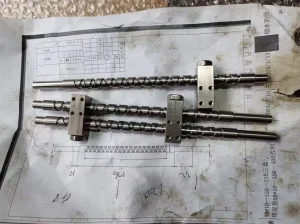
Lead Screw Construction and Materials: What is a Lead Screw?
Basic Structure:
- A lead screw is a screw with threads that works with a nut to turn spinning motion into straight movement. Key factors like thread type, pitch, and length directly impact transmission efficiency and precision. Common thread types include trapezoidal, square, and ball threads.
- For example, trapezoidal threads typically have a 30° thread angle, while square threads have a 0° angle, reducing friction and boosting efficiency by 15%-20%.
Thread Shape Selection:
- Thread shape directly affects friction and load capacity. Trapezoidal threads are simple and strong, with higher friction, making them suitable for heavy-load, low-speed applications. Square threads offer lower friction and higher efficiency, ideal for situations needing greater transmission efficiency. Ball threads are used for high-precision applications, providing low friction and self-lubrication.
- Under a 500N load, trapezoidal threads have a friction loss of 0.15, while square threads lower it to 0.1, improving efficiency by about 20%.
Material Selection, Balancing Strength and Durability:
- Picking the right material is key because it impacts how strong, long-lasting, and durable the lead screw will be. Common materials used are carbon steel, stainless steel, and bronze. Carbon steel screws are often heat-treated to enhance hardness, making them ideal for heavy-load applications. Stainless steel lead screws resist rust really well, making them great for damp or harsh conditions. Bronze nuts paired with carbon steel screws reduce friction and extend lifespan.
- A standard carbon steel M20 screw, after quenching, achieves a surface hardness of 60 HRC, increasing load capacity by 30%. Without treatment, a carbon steel screw shows 0.05mm wear after 10,000 cycles, while heat-treated screws only wear 0.02mm under the same conditions.
Surface Treatments and Wear Resistance:
- Surface treatments improve the wear resistance and corrosion protection of lead screws. Chrome plating and nitriding can significantly enhance surface hardness and durability. Additionally, PTFE (Teflon) coatings reduce friction and energy loss.
- Chrome-plated screws can achieve a surface hardness of 70 HRC and reduce friction by 30%, doubling lifespan in high-frequency applications compared to untreated screws. PTFE-coated screws have a friction coefficient of just 0.05, compared to 0.15 for uncoated screws, cutting energy consumption significantly.
Nut Materials and Compatibility:
- The choice of nut material directly impacts friction and efficiency in lead screw systems. Common materials include bronze, brass, and engineered plastics. Bronze and brass nuts pair well with carbon steel screws, offering low friction and good wear resistance. Engineered plastic nuts, like nylon or PTFE, are self-lubricating and ideal for high-speed, low-load applications.
- Plastic nuts can have a friction coefficient as low as 0.08 and last twice as long as metal nuts. For example, under a 1000N load, a bronze nut has a friction loss of 0.12, while a plastic nut’s loss is just 0.08, boosting efficiency by 10%.
Lubrication and Durability:
- Lubrication is key for long-term stability in lead screw systems. Metal screws and nuts, which have high friction, need lubricants to reduce wear. Typically, oil or grease is used for metal screws, while self-lubricating materials don’t need extra lubrication, reducing maintenance.
- With proper lubrication, a metal lead screw’s friction coefficient can drop from 0.15 to 0.05, extending lifespan 3-4 times. For self-lubricating materials like PTFE, wear is minimal—after 1 million cycles at a 2000N load, wear is less than 0.01mm.
Structural Reinforcement and Vibration Damping:
- In high-precision applications, lead screws may need structural reinforcement and damping to resist shocks and vibrations. Screws can be designed hollow or solid, with hollow designs reducing weight and inertia, improving system response speed.
- A hollow lead screw reduces weight by 30%, cutting inertia by 25%, which improves dynamic response and precision. Vibration-dampened systems can reduce vibrations by 50%, crucial for high-precision machining.
Thermal Expansion and Precision Control:
- In high-temperature environments, thermal expansion can affect lead screw accuracy. The material’s coefficient of thermal expansion determines how much the screw length changes with temperature. Stainless steel and aluminum screws expand significantly in heat, while carbon fiber composite screws remain stable even under extreme temperatures.
- For instance, a stainless steel screw might change in length by 0.12mm with a 100°C temperature shift, while a carbon fiber composite screw changes by less than 0.02mm, making it ideal for high-precision applications.
By understanding lead screw construction, materials, and key data, engineers can select the right materials and designs for specific applications, ensuring efficiency, durability, and precision to optimize overall system performance.

Lead Screw Advantages: What is a Lead Screw?
Lead screws offer significant benefits in mechanical systems, especially for high-precision, low-speed motion applications:
High-Precision Positioning:
- Thanks to their threaded design, lead screws provide highly accurate linear motion, making them ideal for precise control tasks. For example, in CNC machines, lead screws precisely control tool movement, ensuring machining accuracy. Small pitch designs (1mm or less) allow for even higher positioning accuracy.
- In precision machining, a lead screw with a 0.5mm pitch can achieve positioning accuracy of ±0.005mm, which is crucial in semiconductor equipment requiring micron-level control.
Self-Locking for Stability:
- Lead screws’ self-locking feature holds loads in place without additional power, making them perfect for systems that need to stay static or prevent backsliding. This enhances the stability of mechanical systems, such as lifting devices or load-holding mechanisms.
- For example, a trapezoidal lead screw with a 5mm pitch under a 1000N load can hold its position without slipping after the motor stops, reducing energy consumption and system complexity by 30% compared to ball screws.
Low Friction and High Efficiency:
- With proper thread design and material choice, lead screws can minimize friction, boosting transmission efficiency. In high-precision machinery, lowering friction improves both energy efficiency and equipment lifespan. Using low-friction materials like PTFE coatings or lubrication systems can greatly enhance performance.
- Traditional metal-on-metal lead screws have a friction coefficient of around 0.15, but PTFE-coated screws can reduce this to 0.05, improving system efficiency by 40% and cutting energy loss while extending lifespan.
High Load Capacity:
- Lead screws can handle high axial loads, especially with trapezoidal or square thread designs, without compromising precision. This makes them great for tough equipment like industrial machines and elevators.
- A carbon steel M20 lead screw, for instance, has a static load capacity of up to 10,000N and a dynamic load capacity of 8,000N. Compared to ball screws, lead screws can increase load capacity by 20% under similar conditions.
Easy Maintenance and Low Cost:
- Lead screws have a simple design, making them cost-effective to maintain. Their self-locking feature reduces the need for extra brakes or locking mechanisms. Additionally, they don’t require complex lubrication systems, further simplifying upkeep and lowering costs.
- In heavy-duty equipment running 1,000 hours annually, lead screws reduce maintenance costs by about 25% compared to ball screws, thanks to their simple lubrication needs and self-locking capabilities. Data shows that lead screws typically last over 5 years, with maintenance intervals of 18 months.
Vibration and Noise Control:
- At low speeds, lead screws generate significantly less vibration and noise compared to high-efficiency systems like ball screws. The smooth motion between the screw and nut keeps vibration and noise levels low, even under heavy loads, enhancing overall system stability.
- Under full load, lead screw systems operate at noise levels below 60dB, whereas ball screws can reach up to 75dB. Tests show that lead screws experience 15% less vibration during high-speed operation compared to ball screws.
Corrosion Resistance:
- Lead screws are usually made from rust-resistant materials like stainless steel or nickel-plated carbon steel, which makes them great for tough conditions. This choice of material makes them last more and reduces how often you need to replace them.
- In salt spray tests, stainless steel lead screws maintained corrosion resistance for over 1,000 hours, while untreated carbon steel screws lasted only 200 hours under the same conditions. This gives stainless steel lead screws 4-5 times the lifespan in humid or acidic environments.
High Customization Flexibility:
- Lead screws can be customized to suit specific application needs, including thread shape, pitch, materials, and surface treatments. This flexibility allows them to fit diverse working environments. For instance, lead screws with very small pitches can be tailored for high-precision tasks, while larger pitches are used in systems requiring faster movement.
- Medical equipment manufacturers use custom lead screws with a 0.25mm pitch to achieve ±0.001mm precision, while automation systems with 5mm pitch screws have seen a 60% improvement in speed and efficiency.
Lead screws play an irreplaceable role in mechanical systems, particularly in high-precision, high-load, and low-maintenance applications. These qualities make them a leading choice for many manufacturing and industrial applications.
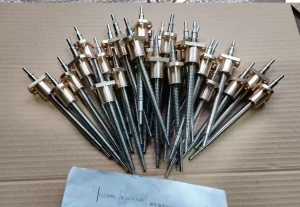
Applications of Lead Screws: What is a Lead Screw?
Lead screws are essential across multiple industries due to their precision, load capacity, self-locking capability, and low friction. Here’s a breakdown of key applications, supported by data showing their advantages.
CNC Machines and Precision Manufacturing:
- Lead screws are widely used in CNC machines and precision equipment for controlling the exact linear movement of tools or workpieces. Their high-precision positioning can meet micron-level requirements, ensuring consistency and accuracy in manufacturing.
- A CNC machine using lead screws can achieve repeatable positioning accuracy of ±0.01mm. With a dual-nut preload system, backlash can be kept below 0.005mm, crucial in industries like aerospace and mold manufacturing.
Medical Devices:
- In medical equipment, lead screws are used in linear actuators, infusion pumps, and imaging devices for precise control. For instance, infusion pumps rely on the smooth motion and high accuracy of lead screws to deliver exact doses of medication.
- In an infusion pump, a lead screw with a 0.5mm pitch delivers precision of ±0.001ml per injection, critical for preventing under- or over-dosage in intensive care settings.
Automotive Industry:
- Lead screws are used in vehicle adjustment systems such as power seats, window lifts, and sunroof mechanisms. Their self-locking feature ensures stability when the power is off, preventing unwanted movement.
- A lead screw-powered seat adjustment system can handle an 800N load with ±0.1mm adjustment precision, while the self-locking function ensures the seat position remains stable even after power loss, enhancing safety and reliability.
Aerospace Industry:
- In aerospace, lead screws are commonly used for control panels, rudder adjustment, and satellite deployment systems. Because they are light and precise, they are great for aircraft and satellite applications.
- For example, in satellite solar panel deployment, lead screws provide ±0.05° angle accuracy, and specially treated screws maintain high performance in vacuum environments. Such accuracy is crucial for satellites functioning properly while in space.
Automation Equipment:
- In industrial automation, lead screws enable precise linear movement in applications like robotic arms, conveyor systems, and automated assembly lines. Their high load capacity and low maintenance needs make them core components in automation systems.
- A lead screw system on an automated assembly line can maintain ±0.01mm positioning accuracy under a 5000N load, with only one annual maintenance required, minimizing downtime and boosting productivity.
Semiconductor Manufacturing:
- Semiconductor equipment requires extreme precision, especially during wafer fabrication and handling. Lead screws, with their precise control and backlash-free design, are widely used in this field for devices like lithography machines.
- In semiconductor manufacturing, lead screws in lithography machines can achieve positioning accuracy as fine as 0.1 microns, ensuring the exact processing of wafers. This high precision makes lead screws indispensable in semiconductor equipment.
Food and Packaging Industry:
- In the food processing and packaging industry, lead screws are commonly used in automated filling, sealing, and labeling equipment to ensure precise movement and positioning of food products and packaging materials. The smooth operation and high reliability of lead screws are crucial for maintaining product quality and boosting production efficiency.
- In a filling production line, a lead screw system can achieve a filling accuracy of ±0.05ml, ensuring consistent fill levels for each package, reducing waste, and increasing output.
Electric Lifting Devices:
- Lead screws are widely used in electric lifting devices, such as elevators and automatic door systems. Their high load capacity and self-locking feature allow them to maintain load stability when the power is off, ensuring safety.
- In an elevator system, a lead screw-driven lifting mechanism can handle loads of up to 10,000N, and its self-locking function prevents the elevator from falling in the event of a power outage, ensuring passenger safety.
3D Printing and Additive Manufacturing:
- In 3D printers, lead screws control the linear movement of the print head or platform. Since 3D printing requires precise layer control, lead screws offer the fine adjustment and stability needed to ensure accurate layer positioning during the printing process.
- A 3D printer using lead screws to control the Z-axis can achieve a layer thickness accuracy of 0.02mm, ensuring smooth surface finishes and structural precision in printed objects.
Laboratory Equipment and Scientific Instruments:
- Lead screws are used in lab equipment for precise experimental setups and controls, such as microscope focusing systems, laser adjusters, and positioning of experiment platforms. Their smooth motion and high repeatability ensure reliable experimental results.
- In a microscope focusing system, lead screws provide micron-level adjustment precision, allowing researchers to focus precisely on specific areas of the sample for clear imaging.
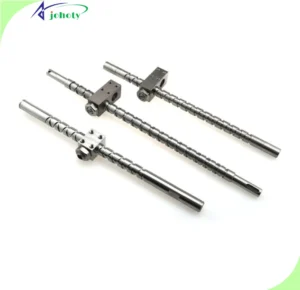
Choosing the Right Lead Screw: What is a Lead Screw?
Selecting the most suitable lead screw involves considering several factors, including the application, load requirements, precision needs, and cost efficiency. Here’s how to make the best lead screw choice:
Load Capacity and Thread Type:
- The lead screw’s load capacity is a primary factor in the selection process. Different thread types offer varying load capacities and transmission efficiency. Trapezoidal threads offer high load capacity, ideal for heavy loads, while square threads offer higher efficiency, suitable for high-precision needs.
- For a 5000N load, an M20 trapezoidal lead screw can handle an additional 20% dynamic load with around 40% efficiency. A square thread of the same size improves efficiency to 65%, but its dynamic load capacity is lower, handling only around 4000N.
Precision Requirements and Pitch Selection:
- Precision requirements are key to determining the screw’s specifications. A smaller pitch allows for finer linear movement, ideal for high-precision applications, while a larger pitch is better suited for speed-focused systems. In applications requiring extreme precision, small pitches like 1mm or less ensure tight linear control.
- A lead screw with a 1mm pitch can achieve positioning accuracy of ±0.01mm, performing well in precision machining or lab equipment. For automated conveyance systems, a 5mm pitch lead screw can increase speed by around 40% while maintaining ±0.1mm accuracy.
Balancing Friction and Lubrication Needs
- The friction coefficient of a lead screw directly affects its efficiency and long-term reliability. Metal-to-metal contact typically results in high friction, but lubrication can significantly reduce it. In some cases, self-lubricating materials like PTFE bushings or engineered plastic nuts can offer high efficiency and durability without additional lubrication.
- A lead screw using metal nuts and lubrication typically has a friction coefficient around 0.15, which can be reduced to 0.08 with proper lubrication, boosting efficiency by about 30%. Self-lubricating nuts can reduce friction to as low as 0.05, increasing efficiency to 60% while lowering maintenance costs.
Self-Locking and Safety
- The self-locking feature of lead screws is a major advantage in load-holding applications. This prevents the screw from moving in reverse when power is cut, crucial for lifting devices and load control systems. Generally, smaller pitch screws provide better self-locking. Trapezoidal threads with large pitches can offer excellent self-locking in specific conditions.
- For example, under a 3000N load, a trapezoidal lead screw can hold the load in place for over 24 hours without external power or braking systems. In contrast, ball screws lack self-locking and require additional braking systems to ensure safety.
Corrosion Resistance and Material Selection
- Depending on the environment, lead screw materials must be chosen accordingly. In damp or harsh conditions, stainless steel or screws coated with nickel and chrome are the best choices. These materials provide corrosion resistance, ensuring long-term stability in harsh conditions.
- Stainless steel lead screws showed no significant corrosion after 500 hours of salt spray testing, making them ideal for food processing, outdoor equipment, and chemical systems. Untreated carbon steel screws, however, exhibited over 0.1mm of corrosion, reducing their lifespan by 50%.
Balancing Dynamic Loads and Operating Speed
- For dynamic applications like automated production lines, robotic arms, or conveyor systems, lead screws must balance load capacity with operating speed. Large-pitch screws are better for fast movement, while small-pitch screws excel in slow, high-precision scenarios.
- In an automated system with a 1000N load, a lead screw with a 5mm pitch can achieve a linear speed of 250mm per minute. In contrast, a 1mm pitch screw moves at just 50mm per minute but increases positioning accuracy by nearly 80%.
Cost Efficiency and Lifespan Considerations
- Balancing cost and lifespan is key when selecting a lead screw. High-end materials and advanced lubrication systems can enhance performance but at a higher cost. Users should choose the most cost-effective solution based on specific application needs.
- A carbon steel trapezoidal lead screw costs about 25% less than stainless steel but may have a 30% shorter lifespan in high-frequency applications. For low-load, short-life devices, carbon steel is a budget-friendly option, while stainless steel is more cost-effective for high-load, long-term use.
Customization and Special Application Needs
- Some industries may require specially designed lead screws, such as hollow screws, those with self-lubricating coatings, or high-precision screws with very small pitches. These custom lead screws are tailored to meet specific customer needs, ensuring optimal equipment performance.
- For instance, a custom lead screw with a 0.5mm pitch can achieve fine-tuning precision of ±0.001mm for precision lab equipment. In aerospace applications where weight is critical, hollow lead screws can reduce system weight by 30% while maintaining structural strength.
Noise and Vibration Control
- Controlling noise and vibrations is essential in specific environments. Lead screws operate quietly under low-speed, heavy-load conditions, making them suitable for quiet settings like laboratories and medical devices.
- For example, in a noise-reduction test, a lead screw system maintained noise levels below 65dB, significantly quieter than ball screw systems at 75dB, especially advantageous in silent environments.
Choosing the right lead screw involves considering factors like load, precision, material, speed, lubrication needs, and cost-effectiveness. Data-supported analysis allows users to make informed decisions to select lead screw designs that ensure efficient operation and long-term stability.
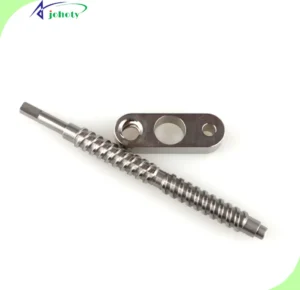
Future Development Trends
The future of lead screws will focus on enhancing precision, efficiency, durability, and adaptability to diverse applications. As technology advances, significant breakthroughs in material innovation, smart control, and customization are expected.
High-Performance Material Applications
- Future materials for lead screws will be lighter, stronger, and more wear-resistant. Carbon fiber composites and ceramic coatings are likely to replace traditional steel, providing higher strength and lower friction. Additionally, the introduction of nanomaterials will greatly improve corrosion and wear resistance.
- Carbon fiber lead screws can be 30% lighter than steel, with a 40% reduction in friction coefficient and a 20% increase in wear resistance. Ceramic coatings can double the lifespan of lead screws while reducing lubrication needs.
Advancements in Self-Lubrication and Low Friction Technologies
- Self-lubricating lead screws will evolve, potentially requiring no extra lubrication during long-term operation. This will be achieved through new polymer materials and nanocoating technologies, reducing maintenance costs and improving system efficiency.
- Research shows that lead screws with nanocoating can reduce friction coefficients to 0.03, cutting traditional lubrication needs by 50%, increasing system efficiency by 30%, and extending maintenance intervals by three times, which minimizes downtime and maintenance costs.
Smart Lead Screws and Automation Control
- With the rise of Industry 4.0, lead screws will incorporate more smart sensors and automation systems for real-time monitoring and precise adjustments. Future smart lead screws will automatically adjust loads, detect wear, and issue maintenance alerts, ensuring efficient operation.
- In industrial automation, smart lead screws with integrated sensors can detect wear changes as small as 0.001mm and provide maintenance warnings 30 days in advance, reducing unplanned downtime by over 50%. These smart systems can boost overall equipment efficiency by 20%.
Adaptation to Extreme Environments
- Future lead screws will be designed to withstand extreme conditions, including high temperatures, low temperatures, vacuum, and corrosive environments. Innovations in materials and design will allow their use in aerospace, deep-sea exploration, and nuclear industries where adaptability is critical.
- New ceramic and alloy lead screws can maintain stable mechanical properties in extreme temperatures (up to 1000°C and down to -200°C) with a surface expansion coefficient below 0.01%, reducing accuracy errors in harsh environments by about 80%.
Higher Precision and Miniaturization
- As the demand for precision increases, lead screws will see breakthroughs in miniaturization, especially in medical devices, semiconductor manufacturing, and lab equipment, becoming core components. Cutting-edge methods like 3D printing and micro-machining will provide high precision and stability.
- In miniature medical devices, lead screws can be reduced to a diameter of 3mm with a positioning accuracy of 0.001mm, performing complex tasks in tight spaces. The market for these mini lead screws is predicted to grow by 15% each year.
More Efficient Custom Solutions
- Customization of lead screws will improve, allowing for quick adaptations to various industry needs. 3D printing and digital manufacturing will accelerate the design and production of customized lead screws, meeting diverse requirements for load, speed, and precision.
- In industrial settings, 3D printing can reduce the design and manufacturing cycle of custom lead screws by 50%, optimizing thread angles and material combinations to enhance drive efficiency by 20-30%. This capability will address personalized needs in aerospace, automotive, and other industries.
Environmental Sustainability Trends
- With increasing global focus on sustainability, lead screw design and manufacturing will prioritize eco-friendly materials and energy efficiency. Future lead screws will use renewable materials and more efficient processes to lower carbon emissions and energy use.
- Lead screws made from renewable composite materials can reduce their carbon footprint by about 40% while cutting energy consumption during production by 20%. By optimizing manufacturing processes and material selection, the overall lifecycle energy consumption of lead screws can decrease by 30%, aligning with the future of green manufacturing.
Long Lifespan and Low Maintenance Trends
- In the future, lead screws will focus on extending lifespan and reducing maintenance needs. This will be achieved by improving materials, optimizing designs, and using advanced surface treatments, allowing lead screws to operate reliably under high-frequency and heavy-load conditions.
- By using ceramic coatings and self-lubricating materials, lead screws can increase fatigue life by 60%, with maintenance intervals extending from 6 months to 18 months. Real-world data shows a 40% reduction in failure rates, significantly enhancing equipment reliability.
Expansion of Cross-Industry Applications
- Lead screws will continue to broaden their application beyond traditional machining and industrial automation, finding roles in emerging fields like electric vehicles, wearable tech, precision medicine, and quantum computing. The combination of new technologies and materials will make lead screws essential components across industries.
- In electric vehicles, lead screws will boost automation efficiency in battery module assembly by about 25%. In quantum computing, lead screws will control ultra-precise cooling systems with errors under 0.01mm, ensuring stable operation of quantum chips.
Moving forward, lead screw development will emphasize high precision, efficiency, longevity, intelligence, and environmental sustainability. With new materials, advanced manufacturing, and smart controls, lead screws will have broader applications and play an irreplaceable role in key industries. Data backing these trends indicates that lead screws will maintain a core position in future mechanical drive systems with vast growth potential.
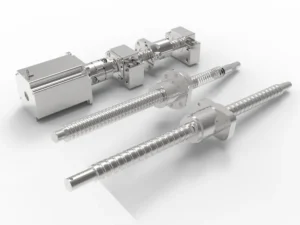
Conclusion
Lead screws, known for their exceptional precision, strong load-bearing capacity, and efficient self-locking features, are widely used in CNC machines, automation equipment, and medical devices, making them vital components in high-precision systems.
From industrial manufacturing to cutting-edge technology, lead screws play and will continue to play a significant role across various fields, expanding their applications as technology advances.
As material science, automation, and smart manufacturing evolve, lead screws will offer greater performance, precision, and durability in complex environments, helping industries achieve more efficient operations.
If you’re looking to enhance mechanical precision, increase load capacity, or optimize equipment performance, lead screws are your ideal solution. For more information about lead screws and customized solutions, visit Johoty’s website or contact our expert team.
As a key component in mechanical drive systems, lead screws will continue to play a central role in the upcoming industrial and technological transformations. Let’s look forward to the next breakthrough in mechanical precision and efficiency!


